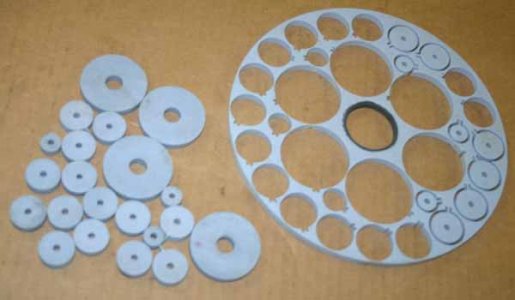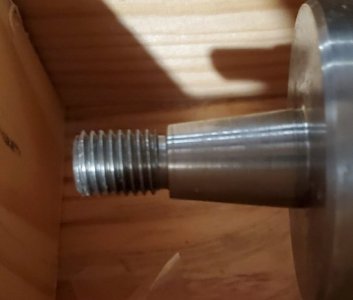TorontoBuilder
Sapientia et Doctrina Stabilitas
So, I have a tool post grinder. It is missing the ID grinding accessory quill. It is supposedly just the one shown below.
The external grinding wheel hub is supposed to detach and the extension is then mounted in its place. This does not seem like it would be very precise and must rely on dressing the stone significantly in order to true things up.

ID grinding wheels up to 1" in diameter can then be mounted as shown. This is a very limited design in that small diameter wheels cannot be mounted. There is also the risk the wheel can be cracked while tightening it onto the quill. But it would be very easy to make an extension.
However, I'd really like easy to swap quills that are affixed to the spindle via a taper, or a locator shaft with threaded end as shown below:

The upper version looks perfect, except I can't find small diameter grinding bits mounted on threaded arbor like is shown. Anyone seen such animals around for purchase? I can find abrasives cones that would glue on like shown in the lower version but the selection I've found at KBC is limited
Next question, if I make quills and bore and ream the end to common grinding point diameters 1/8, 1/4 etc, what is likely better mounting method... heat shrink fitting, Loctite red adhesive, or CA glue? The bore for the shank will be deep enough so that the abrasive sits very close to the end of the quill. I want to use diamond and borazon bits that can't be dressed to run true so the mounting method must be as precise as possible.
For the above reason I'm leaning towards either buying, or making a second spindle that fits the tool post grinder bore. Anyone know a source for affordable belt drive spindles, either with a collet, or a threaded locator bore as I've shown?
The external grinding wheel hub is supposed to detach and the extension is then mounted in its place. This does not seem like it would be very precise and must rely on dressing the stone significantly in order to true things up.
ID grinding wheels up to 1" in diameter can then be mounted as shown. This is a very limited design in that small diameter wheels cannot be mounted. There is also the risk the wheel can be cracked while tightening it onto the quill. But it would be very easy to make an extension.
However, I'd really like easy to swap quills that are affixed to the spindle via a taper, or a locator shaft with threaded end as shown below:
The upper version looks perfect, except I can't find small diameter grinding bits mounted on threaded arbor like is shown. Anyone seen such animals around for purchase? I can find abrasives cones that would glue on like shown in the lower version but the selection I've found at KBC is limited
Next question, if I make quills and bore and ream the end to common grinding point diameters 1/8, 1/4 etc, what is likely better mounting method... heat shrink fitting, Loctite red adhesive, or CA glue? The bore for the shank will be deep enough so that the abrasive sits very close to the end of the quill. I want to use diamond and borazon bits that can't be dressed to run true so the mounting method must be as precise as possible.
For the above reason I'm leaning towards either buying, or making a second spindle that fits the tool post grinder bore. Anyone know a source for affordable belt drive spindles, either with a collet, or a threaded locator bore as I've shown?


